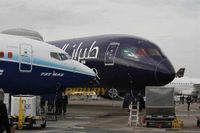After years of turbulence, Boeing is regaining its footing in the aviation industry as the U.S. Federal Aviation Administration (FAA) announced it will restore the company’s ability to certify its own 737 Max and 787 Dreamliner jets for flight. This decision comes more than six years after two devastating crashes involving the then-new 737 Max model killed 346 people and led to a global crisis in confidence for both Boeing and the FAA, as reported by The Associated Press.
Starting Monday, September 29, 2025, Boeing will be permitted to resume issuing airworthiness certificates for certain 737 Max and 787 Dreamliner aircraft. This marks a significant shift: since 2019, the FAA had taken full control over the certification process for these models after uncovering serious lapses in Boeing’s manufacturing quality and safety oversight. The move to restore Boeing’s limited self-certification authority follows what the FAA describes as “a thorough review of Boeing’s ongoing production quality.”
“Safety drives everything we do, and the FAA will only allow this step forward because we are confident it can be done safely,” the agency said in a statement, according to The Seattle Times. The FAA’s decision doesn’t mean Boeing is returning to business as usual. Instead, the agency is implementing a new system: Boeing and FAA inspectors will alternate weekly in performing the final safety checks required before aircraft are delivered and declared safe to fly. This arrangement, the FAA claims, will free up more of its inspectors to conduct “rigorous” quality checks on Boeing’s production lines, allowing for more direct oversight of critical assembly stages and broader trends within the company.
The return of some self-certification privileges comes with continued regulatory strings attached. The FAA has renewed Boeing’s Organizational Designation Authorization (ODA)—the program that allows certain Boeing employees to work on behalf of the FAA for certification tasks—for three years. However, the ODA program itself has been under heavy scrutiny. Unit members have alleged they felt pressured by Boeing management to approve tasks quickly in order to meet tight schedules and delivery deadlines. This pressure, according to the FAA, contributed to past lapses in safety oversight. “Resuming limited delegation to the Boeing ODA will enable FAA inspectors to provide additional surveillance in the production process,” the FAA emphasized, stating that there will be more inspectors observing critical assembly and ensuring compliance with approved designs.
The FAA’s renewed confidence in Boeing comes despite lingering concerns about the company’s culture and safety practices. Recent FAA audits uncovered hundreds of quality system violations at Boeing’s Renton, Washington facility. The agency has imposed a cap on Boeing’s monthly production of 38 737 Max aircraft—a measure put in place after a January 2024 incident in which a paneled-over exit door blew out during an Alaska Airlines flight. In September 2025, the FAA also announced a proposed $3.1 million fine against Boeing for safety violations between September 2023 and February 2024, including allegations of “undue pressure” on ODA unit members to sign off on aircraft that did not fully comply with standards.
According to AirData News, the FAA’s ongoing criminal investigations into Boeing’s practices remain unresolved. The agency is probing incidents where Boeing allegedly submitted two non-airworthy aircraft for approval. These investigations serve as a stark reminder that the company’s path back to normalcy is fraught with continued oversight and accountability.
Despite these challenges, the FAA’s decision appears to have injected renewed optimism into both Boeing and its investors. The company’s stock price surged about 4% following the FAA announcement, buoyed further by news of major new orders from international airlines. Turkish Airlines, after a meeting between Turkish President Erdogan and former U.S. President Trump, revealed plans to purchase 75 Dreamliners and expressed an intent to eventually buy up to 150 more 737 Max jets—a deal that, if finalized, would represent the largest single order for Boeing’s best-selling aircraft. Norwegian Group, which operates Norwegian Air Shuttle and Widerøe, also placed an order for 30 Boeing 737 Max 8 planes. Additionally, Boeing secured a deal with Uzbekistan Airways for up to 22 aircraft, as reported by AirData News.
These commercial victories are critical for Boeing’s bottom line. The 737 Max and 787 Dreamliner models represent significant portions of the company’s backlog and are mainstays in airline fleets worldwide. Any changes in certification or production rates have a ripple effect across the global aviation supply chain, impacting airline deliveries, maintenance schedules, and even the broader economy in regions where Boeing operates.
Boeing has responded to the renewed scrutiny by implementing a series of reforms. Following the Alaska Airlines panel blowout, the company designed and implemented a comprehensive safety and quality plan. According to its annual safety briefing, Boeing has hired an ombudsperson to act as a neutral third party for employee concerns, increased the number of staff authorized to perform FAA tasks, and improved its internal pipeline to address retirements and ensure continuity in safety oversight. The company claims these measures have led to improvements in its oversight program and safety culture.
The FAA, for its part, is not taking Boeing’s word at face value. The agency has pledged to continue observing Boeing’s safety culture closely, ensuring that employees feel empowered to report concerns without fear of retaliation. This is a critical point: past investigations revealed that some employees felt unable to speak up about safety issues due to pressure from management. The FAA’s continued vigilance aims to prevent a repeat of those failures.
Meanwhile, Boeing executives are preparing to ask the FAA to lift the current production cap in the coming months, arguing that their reforms have made the company’s manufacturing processes safer and more reliable. Whether the FAA will grant that request remains to be seen; for now, the regulator is keeping a tight leash on Boeing’s output to ensure that quality is not sacrificed for quantity.
The restoration of Boeing’s certification authority is a pivotal moment for both the company and the broader aviation industry. It signals a tentative return to normalcy after years of crisis, but it also serves as a reminder of the importance of robust oversight and a strong safety culture. As Boeing works to rebuild trust with regulators, airlines, and the flying public, the world will be watching to see if the lessons of the past have truly been learned.
For Boeing, the road ahead is still paved with challenges, but the company’s recent wins and the FAA’s cautious endorsement suggest that a new chapter may be beginning—one where safety and accountability take center stage, and the skies are just a little bit safer for everyone.


